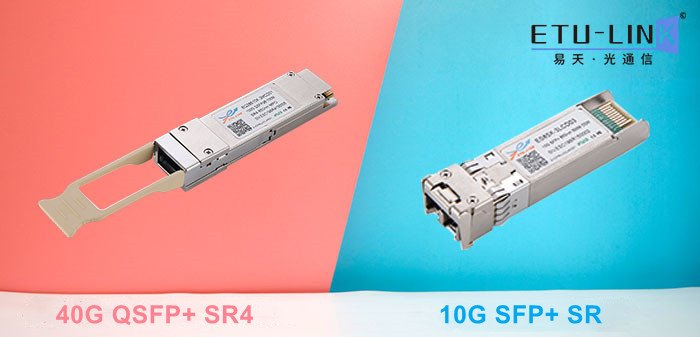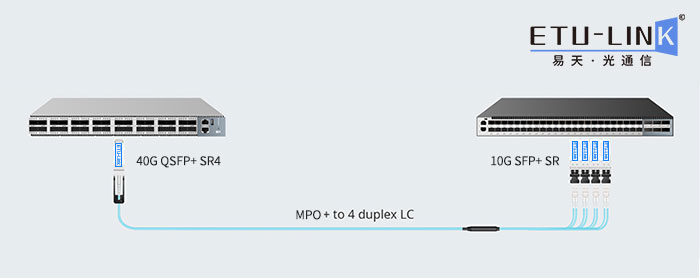
40G QSFP+ SR4 and 10G SFP+ SR networking connection solution
The current branch deployment of ports has become one of the popular ways to build networks, and has driven the development of the parallel optical module market. At present, the commonly used parallel modules are 40G QSFP+ SR4 and 100G QSFP28 SR4, which can be converted into four 10G/25G links for link. This parallel optical module is conducive to multi-link applications, such as the construction of large ridge-blade network structures can be applied to high-density 10G/25G networks. This article ETU-LINK introduces the cost-effective port branch connection scheme of 40G QSFP+ SR4 and 10G SFP+ SR.
Because of the explosion of wireless and mobile devices, cloud data centers and enterprises are constantly upgrading their networks, so data centers are often the earliest adopters of the highest transfer rates. A density revolution has taken place in the world of structured cabling, where the density of data center passive fiber hardware has doubled to reach the number of ports in 288 cores in a 4U fiber distribution frame, whether LC or MTP connectors. This increase has been transferred to the switch side, where the deployment of the port branch configuration can enable a switch board to handle 10G networks with three times the processing capacity.
Before we understand port branching deployment, we need to understand the types of optical modules. The current dominant high-density 1G and 10G optical modules, with speeds increasing to 40G, 4-channel miniaturized pluggable design (QSFP+) has become the high-density optical module of choice. The 40G QSFP+ SR4 optical module is configured with four separate 10G optics that emit light from the front end of the optical module via an eight-core fiber, a design that allows the 40G transceiver to operate as four separate 10G links or a single native 40G link.

Running 10G networks on parallel ports, high-density SFP+ switch line cards are usually equipped with up to 48 ports. However, with 36 QSFP+ ports operating in branch mode, each 40G port can function as four separate 10G ports, tripling the cable card capacity to 144 10G ports on a single cable card.

The 36 ports of QSFP in port branching mode can support a total of 144 10G links, as each 40G port can act as four 10G links. To support the same number of 10G links as traditional SFP+ transceivers, three switches with 48 SFP ports are required. As the demand for 10G port capacity increases, this impact will continue to grow, and this solution can significantly reduce the footprint of 10G data centers.
Categories
New Blog
Tags
© Copyright: 2025 ETU-Link Technology CO ., LTD All Rights Reserved.

IPv6 network supported
Friendly Links:
易天官网